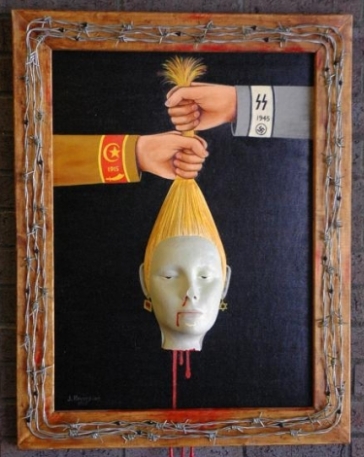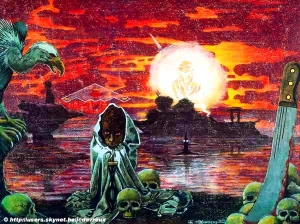Dr. Jack Kevorkian, who was known as “Dr. Death” for his role in advocating physician-assisted suicide, was also known for his artistic works, which often shared a similar controversy. Among these is his 1915 Genocide 1945 painting. It is an image of a woman’s head being held by two hands. One hand represents the Armenian Genocide and the other represents the Nazi Holocaust. It is said that Kevorkian included some amount of real blood in this painting, which is also wreathed in barbed wire.
I think this is a powerful image because it strongly demonstrates that genocide subordinates human life in favor of an ideology. The woman’s head is being displayed as a prize. It is a prize because it is symbolic of what those who commit genocide revile, and, therefore, a symbol of victory. The act of mass killing becomes victory of a cause. It’s also important that Kevorkian used a woman’s head in the painting, because this further demonstrates that genocide is not an act between soldiers. Genocide indiscriminately targets those who are “other,” because it is an attempt to eliminate an entire group of human beings.
After some dispute with his estate, Kevorkian’s painting is on display at the Armenian Library and Museum of America, in Watertown, Massachusetts.
__________
This is a painting by Belgian artist Jean-Claude Davreux, titled Child-Soldier, which interprets the genocide in Rwanda.
There’s a lot going on in this image. The colors are rather angry and the texture is coarse and aged. My favorite aspect is the ambiguous nature of the child. Based simply on what the content provides, you can’t tell whether the child is a participant in the genocide or a survivor. His stare is calculated, which is suggestive of his role, but not definitive. The only aspect that definitively answers this is the painting’s title – Child-Soldier. If we weren’t privy to this information, then we may identify him as a survivor of the atrocities. I think the most important insight to gain from this kind of painting is the realization that he is both the participant in the genocide and one of its victims. Children aren’t born with such ideologies that produce genocide, in the same way that they aren’t born racists. They only become such as the result of exposure to adult biases. Considering that these children are often turned into soldiers after having watched their family killed in front of them, there’s no reason why we shouldn’t feel compassion towards them. They were deliberately made to be something they otherwise would not have become.


I loved your interpretations of these paintings, especially that of Child Soldier. Your point that as a child soldier, the child is both a perpetrator and a victim of this genocide is very relevant. I recently did some reading on child soldiers in Africa and I was personally appalled at how young these children are being forced into militia service under penalty of death and trained and forced to commit atrocities themselves.
You present two very powerful images that contain multi-layered symbolism. I did not know that Kevorkian was also an artist. This painting of the woman’s head held as a prize is intense in its portrayal of the effects of genocide masked as a victory but truly just a murder in disguise.